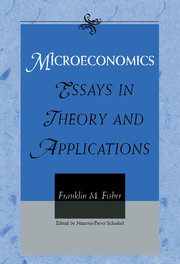Book contents
- Frontmatter
- Contents
- Introduction
- Part I Disequilibrium and Stability
- Part II Welfare Economics and Consumer Theory
- Part III Applications of Microeconomic Theory
- 19 On Donor Sovereignty and United Charities (1977)
- 20 A Proposal for the Distribution Abroad of the United States' Food Surplus (1962)
- 21 A Theoretical Analysis of the Impact of Food Surplus Disposal on Agricultural Production in Recipient Countries (1963)
- 22 US Experience: The Recent INS Study (1970)
- 23 Aspects of Cost-Benefit Analysis in Defence Manpower Planning (1969)
- Part IV Industrial Organization, Economics, and the Law
- Part V Public Policy Applications
- Epilogue
- Indexes
22 - US Experience: The Recent INS Study (1970)
Published online by Cambridge University Press: 20 March 2010
- Frontmatter
- Contents
- Introduction
- Part I Disequilibrium and Stability
- Part II Welfare Economics and Consumer Theory
- Part III Applications of Microeconomic Theory
- 19 On Donor Sovereignty and United Charities (1977)
- 20 A Proposal for the Distribution Abroad of the United States' Food Surplus (1962)
- 21 A Theoretical Analysis of the Impact of Food Surplus Disposal on Agricultural Production in Recipient Countries (1963)
- 22 US Experience: The Recent INS Study (1970)
- 23 Aspects of Cost-Benefit Analysis in Defence Manpower Planning (1969)
- Part IV Industrial Organization, Economics, and the Law
- Part V Public Policy Applications
- Epilogue
- Indexes
Summary
This paper summarizes a cost-benefit analysis of re-enlistment incentives in the United States Navy performed some time ago at the Institute of Naval Studies (INS) (Morton et al. (1966)) and considers some of the lessons to be learned from it. See also Fisher and Morton (1967) and Fisher (1967). Since the study was undertaken before the Vietnam buildup, its direct applicability is to what one hopes will be the normal situation of a peacetime Navy.
The Perceived Problem: Re-enlistment Incentives in the US Navy
Men enlisting for the first time in the United States Navy do so for a four-year term. A very large fraction of such men leave after four years; most of the remainder become career men and continue in the Navy until retirement. At the time of the INS study the Navy perceived its first-term re-enlistment rate (the one after four years) as undesirably low. A firstterm enlisted man typically spends six to twelve months largely in training and, of course, improves the skills so acquired through on-the-job experience. If he leaves at the end of the first term, the human capital that the Navy has built up through its investment in such training and experience becomes dissipated so far as the Navy is concerned. This problem was naturally felt to be particularly acute in occupations requiring extensive technical training, principally that of electronics maintenance and repair.
In this situation, thought was given to offering different incentive packages to affect favourably the crucial decision – that of first-term reenlistment. Such packages ranged from pay increases through rapid promotion and a variety of fringe benefits.
- Type
- Chapter
- Information
- MicroeconomicsEssays in Theory and Applications, pp. 310 - 324Publisher: Cambridge University PressPrint publication year: 1999



